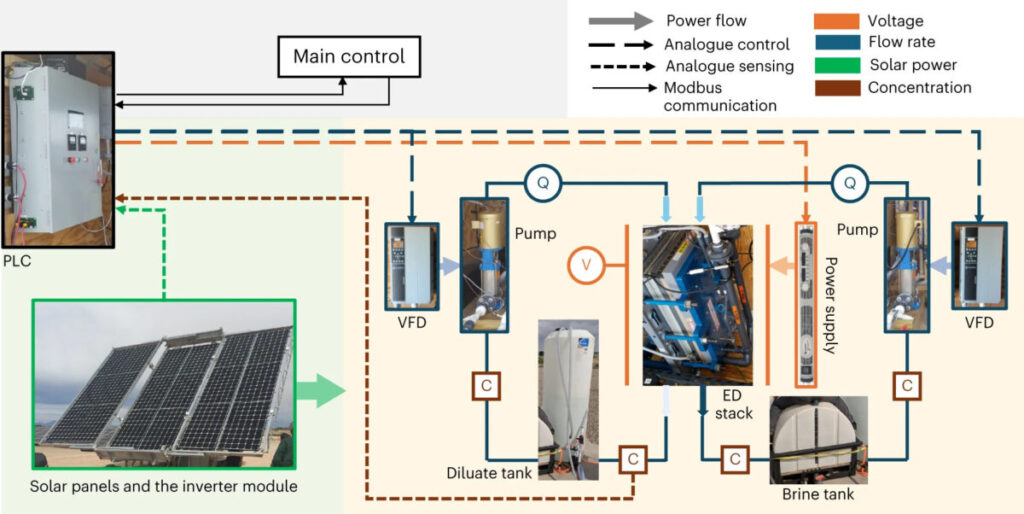Scientists led by the Massachusetts Institute of Technology (MIT) have designed a new solar-powered desalination system based on time-varying electrodialysis reversal (EDR) technology. The proposed system is reported to achieve lower levelized costs of water than traditional solar-powered desalination technologies.
A global group of scientists led by the Massachusetts Institute of Technology (MIT) has developed a new low-cost solar-powered brackish water desalination system that can reduce the levelized cost of water (LCOW) compared to traditional solar-powered desalination systems. It is reported that a desalination system has been developed.
The proposed desalination system utilizes a time-varying electrodialysis reversal (EDR) technique developed by researchers as a flexible variation of conventional EDR desalination. “Our research aims to address water scarcity in rural India, where groundwater is largely saline and undrinkable. “The stability is not good,” said corresponding author Wei He. PV magazine.
“The EDR module consists of a stack of ion-exchange membranes that use an electric field to move ions from the dilution channel to the brine channel between each membrane,” the research group said. “This electric field can be reversed intermittently to prevent scale build-up on the membrane.”
However, due to the intermittent nature of solar energy, traditional EDR is not a perfect fit. Because they require constant power to operate, PV-EDR plants require the support of batteries or large solar power systems, especially at the beginning and end of the day when solar power is scarce.
“To overcome these issues, we developed a flexible batch EDR technology that incorporates time-varying voltage and flow regulation,” the academics explained. “Model-based control techniques allow the EDR system to match power consumption to available solar power generation at each time step while optimizing water production under different solar conditions.”
To control the operation, the team created a feedforward, model-based main controller running in Python to calculate the optimal pump flow rate and EDR stack voltage based on real-time sensor readings. The prototype was built in a research facility and closely reflected the typical design parameters and operating conditions of a PV-EDR system on a regional scale capable of producing 6 m3 of fresh water per day. It had an area of 37 square meters and was powered by solar panels tilted at 30 degrees.
This pilot system was tested with one-day and six-day analyzes and compared to a traditional always-on EDR system. Both systems were fed with water with an average starting salinity of 970 mg l−1. The system was set at a conservatively low water recovery rate of 60%.

Image: Massachusetts Institute of Technology, Nature Water, CC BY 4.0 DEED
“Flexible systems can directly harness an average of 77% of the available solar energy, compared to only about 40% (91% increase) for conventional systems,” the scientists highlighted. “This suggests that operating a conventional system directly (i.e. without energy storage) would require much more solar panel area, increasing capital costs.”
Additionally, the analysis found that the average minimum battery capacity required for the flexible system was 0.27 kWh, a 92% reduction compared to 3.3 kWh for the constant system. “Ultimately, the results show that the flexible system can reach production volumes up to 54% faster than the conventional system,” they added.
Following the experimental results, the researchers conducted a case study to analyze the costs of using such a system in Cherur, a rural Indian village near Hyderabad. Using computer simulation and optimization, it was compared to a conventional HE PV-EDR system, a state-of-the-art stationary PV-EDR, and a commercial on-grid reverse osmosis (RO) desalination system. “RO uses pressure to force water through a polymer membrane, whose constituent ions are blocked by the membrane,” the research group said.
“The optimized levelized cost of water (LCOW) achieved by the proposed flexible PV-EDR system is USD 1.66 m3, which is lower in cost compared to current state-of-the-art PV-EDR systems. 22% and 46% compared to traditional PV-EDR systems,” the scientists found. “The LCOW of on-grid RO was USD 1.71 million, which is 3% higher than the LCOW of flexible PV-EDR.”
Their findings were published in “Flexible batch electrodialysis for low-cost solar-powered brackish water desalination,” natural water. The team included researchers from King's College London in the UK and the Helmholtz Erlangen Nuremberg Institute for Renewable Energy Research (HI ERN) in Germany.
“The next step is to investigate the long-term performance and extend the scope of our PV-EDR technology beyond brine desalination, thereby enabling a wide range of global applications related to water and liquid waste treatment. “We have an important opportunity to address the challenges,” he concluded. .
This content is copyrighted and may not be reused. If you would like to collaborate with us and reuse some of our content, please contact us at editors@pv-magazine.com.


